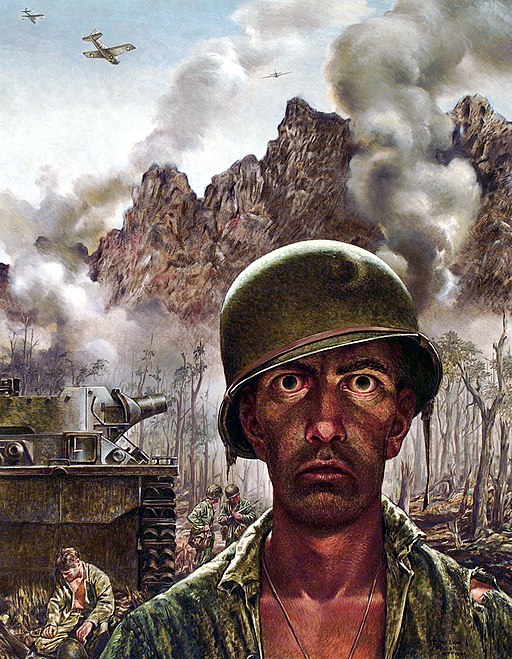
“Both Members of This Club” by George Bellows is the third and largest of George Bellows’s early prize-fighting subjects.
The painting’s title refers to the practice in private athletic clubs of introducing the contestants to the audience as “both members” to circumvent the law.
The Lewis Law made prize-fighting illegal in New York State. Boxing continued in New York on a club membership basis until 1911.
Boxing was a controversial subject, but the interracial theme made this painting even more so, especially since the black boxer appears to be winning the match.
This painting follows the success of the African American professional prizefighter Jack Johnson, who had won the world heavyweight championship in 1908. The idea of a black boxing champion was unsettling to then social order.
Painted the era of Jim Crow laws, Bellows’s painting showing a white fighter about to be defeated by a black boxer was a provocative social commentary. Many believed that interracial boxing should be outlawed.
Jim Crow Laws
Jim Crow laws were state and local laws that enforced racial segregation in the Southern United States. The laws were enforced until 1965. In practice, Jim Crow laws mandated racial segregation in all public facilities in specific states.
The legal principle of “separate but equal” racial segregation was extended to public facilities and transportation, including the coaches of interstate trains and buses.
As a body of law, Jim Crow institutionalized economic, educational, and social disadvantages for African Americans and other people of color.
In 1954, segregation of public schools was declared unconstitutional by the U.S. Supreme Court. In some states, it took many years to implement this decision.
Generally, Jim Crow laws were overruled by the Civil Rights Act of 1964 and the Voting Rights Act of 1965.
The Ancient History of Boxing
The earliest known depiction of boxing comes from a Sumerian relief from over 4,000 years ago. A relief sculpture from Egyptian Thebes dated to 1350 BC shows boxers and spectators.
These early Middle-Eastern and Egyptian depictions showed contests where fighters were either bare-fisted or had a band supporting the wrist.
The earliest evidence of fist-fighting with gloves can be found on Minoan Crete about 1500 BC.
Various types of boxing existed in ancient India. The earliest references come from Vedic epics such as the Ramayana and Rig Veda.
In Ancient Greece, boxing was a well-developed sport and enjoyed consistent popularity. In Olympic terms, it was first introduced in the 23rd Olympiad, 688 BC.
Boxing was a popular spectator sport in Ancient Rome, and fighting events were held at Roman Amphitheatres.
Records of Classical boxing disappeared after the fall of the Western Roman Empire when the wearing of weapons became common once again, and interest in fighting with the fists waned.
In Modern history, as the wearing of swords became less common, there was renewed interest in fencing with the fists. The sport resurfaced in England during the early 16th century in bare-knuckle boxing, sometimes referred to as prizefighting.
The first documented account of a bare-knuckle fight in England appeared in 1681. This is also the time when the word “boxing” first came to be used.
Both Members of This Club
- Title: Both Members of This Club
- Artist: George Bellows
- Date: 1909
- Medium: Oil on canvas
- Dimensions: Height: 115 cm (45.2″); Width: 160.5 cm (63.1″)
- Category: American Artist
- Museum: National Gallery of Art, DC
George Bellows
George Bellows (1882 – 1925) was an American realist painter known for his bold depictions of urban life in New York City.
Bellows was part of the Ashcan School, an artistic movement in the United States during the early 20th century.
Best known for works portraying daily life scenes in New York, often in the city’s poorer neighborhoods. The movement has been seen as symbolic of the spirit of political rebellion of the period.
George Bellows
- Name: George Wesley Bellows
- Born: 1882 – Columbus, Ohio USA
- Died: 1925 (aged 42) – New York City, NY USA
- Nationality: American
- Movement: Ashcan School, American realism
- Notable Works:
- Cliff Dwellers
- Men of the Docks
- Dempsey and Firpo
- River Front No. 1
- New York
- Both Members of This Club
- The Art of Boxing
- Stag at Sharkey’s
- Club Night
Virtual Tour of the National Gallery of Art
- “Ginevra de’ Benci” by Leonardo da Vinci
- “A Young Girl Reading” by Jean-Honoré Fragonard
- “Small Cowper Madonna” by Raphael
- “The Alba Madonna” by Raphael
- “Nude on a Divan” by Amedeo Modigliani
- “Nude on a Blue Cushion” by Amedeo Modigliani
- “Saint Jerome” by El Greco
- “The Houses of Parliament, Sunset” by Claude Monet (National Gallery of Art, DC)
- “Breezing Up (A Fair Wind)” by Winslow Homer
- “Madame Moitessier” by Jean-Auguste-Dominique Ingres
- “Adrienne (Woman with Bangs)” by Amedeo Modigliani
- “Watson and the Shark” by John Singleton Copley
- “The Emperor Napoleon in His Study at the Tuileries” by Jacques-Louis David
- “The Boating Party” by Mary Cassatt
- “Interior of the Pantheon, Rome” by Giovanni Paolo Panini
- “Marcelle Lender Dancing the Bolero in “Chilpéric” by Henri de Toulouse-Lautrec
- “Quadrille at the Moulin Rouge” by Henri de Toulouse-Lautrec
- “A Dutch Courtyard” by Pieter de Hooch
- “The Mother and Sister of the Artist” by Berthe Morisot
- “New York” by George Bellows
- “Self-Portrait” by John Singleton Copley
- “Self-Portrait” by Benjamin West
Boxing – From Ancient Times to Padded Glove
~~~
“The artist is the person who makes life more interesting or beautiful, more understandable or mysterious, or probably, in the best sense, more wonderful.”
– George Bellows
~~~
Photo Credit: 1) George Bellows [Public domain]
Popular this Week








 Sponsor your Favorite Page
Sponsor your Favorite Page SEARCH Search for: Search Follow UsJoin – The JOM Membership Program
Sponsor a Masterpiece with YOUR NAME CHOICE for $5
Share this:
- Tweet
